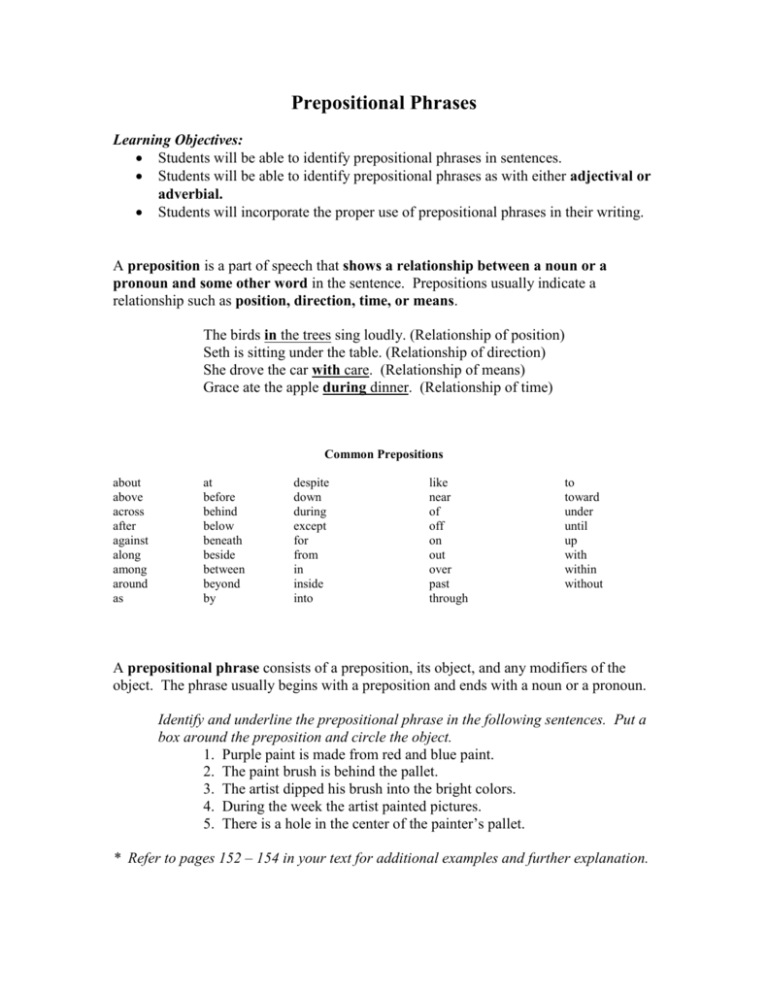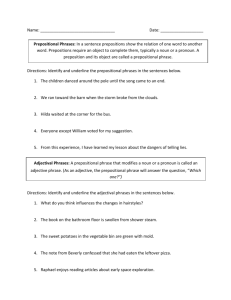Prepositional Phrases
advertisement

Prepositional Phrases Learning Objectives: Students will be able to identify prepositional phrases in sentences. Students will be able to identify prepositional phrases as with either adjectival or adverbial. Students will incorporate the proper use of prepositional phrases in their writing. A preposition is a part of speech that shows a relationship between a noun or a pronoun and some other word in the sentence. Prepositions usually indicate a relationship such as position, direction, time, or means. The birds in the trees sing loudly. (Relationship of position) Seth is sitting under the table. (Relationship of direction) She drove the car with care. (Relationship of means) Grace ate the apple during dinner. (Relationship of time) Common Prepositions about above across after against along among around as at before behind below beneath beside between beyond by despite down during except for from in inside into like near of off on out over past through to toward under until up with within without A prepositional phrase consists of a preposition, its object, and any modifiers of the object. The phrase usually begins with a preposition and ends with a noun or a pronoun. Identify and underline the prepositional phrase in the following sentences. Put a box around the preposition and circle the object. 1. Purple paint is made from red and blue paint. 2. The paint brush is behind the pallet. 3. The artist dipped his brush into the bright colors. 4. During the week the artist painted pictures. 5. There is a hole in the center of the painter’s pallet. * Refer to pages 152 – 154 in your text for additional examples and further explanation. A prepositional phrase is always connected to another word in a sentence, modifying the word in the same way that an adjective or an adverb would. The phrase can be identified as adjectival or adverbial, depending on how it is used in the sentence. An Adjective Prepositional Phrase will modify a noun or a pronoun by answering: Which one? -or- How many? -or- What kind? Usually an adjectival prepositional phrase will immediately follow the noun or pronoun that it is modifying and can not be moved within the sentence. The man in the three-piece suit looks stern. (Modifies man; answers: Which one?) The activity period included classes in painting, poetry, and drama. (Modifies classes; answers: What kind?) --------------------------------------------------------------------------------An Adverb Prepositional Phrase will modify a verb, an adjective, or an adverb by telling: Where? -or- When? -or- How? -or- Why? -or- To what extent? Usually an adverbial phrase can be moved around to different positions of the sentence and the meaning of the sentence will remain clear. I am going to school. (Modifies going; answers: Where?) I am going to school for one hour. (Modifies going; answers: When?) I am going to school for one hour to study. (Modifies going; answers Why?) Practice: Identify if the boldfaced prepositional phrases are adjectival or adverbial. 1. By all means, talk to another doctor. 2. A pit of quicksand stretched between me and my dog. 3. According to the legend, the old prospector found a rich vein of silver in the abandoned mine. 4. The coach gave an award to the hardest worker. 5. Leaping high for the ball, the left fielder made the catch in front of the fence. 6. The book with the blue cover belongs to Jennie. * Refer to pages 155 - 157 in your text for additional examples and further explanation.








